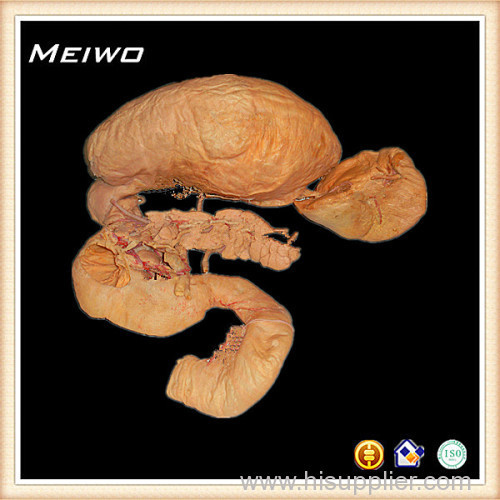

|
Meiwo Science Co.,Ltd
|
| Price: | 320.0 USD |
| Payment Terms: | T/T,L/C,WU |
| Place of Origin: | Henan, China (Mainland) |
|
|
|
| Add to My Favorites | |
| HiSupplier Escrow |
Product Description

specification:Pancreas and duodenum plastinated specimens in vitro,showing the pancreatic duct.
| product name | Pancreas and duodenum plastinated specimens |
| model no | MWSH-077 |
| place of origin | The Chinese city of Zhengzhou in Henan province |
| material | Silicon rubber |
| specification | Pancreas and duodenum plastinated specimens in vitro,showing the pancreatic duct. |
Exhibition Centre
Meiwo has own exhibition center of science museum for customer visit.You can see various specimens ,models, manikins,etc .Pancreas and duodenum plastinated specimens.

Packaging & Shipping
Our Package is neutral package by Plywood case and Flight case,inner side with white polyfoam.Of course, we are glad to do the package as per customer requirements.
Loading cuontainers normally;Also we could load containers with pallets.Pancreas and duodenum plastinated specimens.

Our shipping is various way according to the request, such as by sea,by air,by international express(UPS,EMS,FEDEX,DHL,etc). We have our own freight forwarder agent and you won't worry anything for the shipment. Of course, If you have your own agent and just let me know its contact information and we can get in touch with them.Pancreas and duodenum plastinated specimens.

Company Information
Meiwo Science is a large manufacturer appointed by National Ministry of Education and one of the large model producing factories in China,combination with design ,reasearch and develpoment ,producing,sales,solution,installation, after sales services. The main products is plastinated specimens, teaching models, anatomical models,casting specimens, Pathology specimens ,animal specimens,human skeleton specimens and surgical instruments etc.Pancreas and duodenum plastinated specimens.

The advantage of our plastinated specimens
1. the shrinkage rate of plastinated specimens' is less than 10 percent
2 the surface of plastinated specimens is durable, flexible, authentic and do not shrink.
3. anatomy technology is craft and the facial expression of plastinated specimens is natural .
4. the whole body plastinated specimens have all postures, for example, playing, dancing, drawing, ect.natural harmony.
5. plastinated specimens color is white and it is nearly to skin color.
6. easy to preserved, no consideration of external condition, no ventilation, no be controlled by temperature and humidity.
7. above 5 years for warranty.
Procedure in making plastinated specimens
The plastinated specimens take a long time to complete, for they are all handmade. There are five steps in the standard process of plastination:
1.Embalming and Anatomical Dissection
Pumping formalin into the body through the arteries in order to halt decay. Formalin kills all bacteria and chemically. Using dissection tools, the skin, fatty and connective tissues are removed in order to prepare the individual anatomical structures.
2.Removal of body fat and water
In the first step, the body water and soluble fats are dissolved from the body by placing it into a acetone bath.
3.Forced Impregnation
This second exchange process is the major step in plastination. During forced impregnation a reactive polymer, for example, silicone rubber, replaces the acetone. To achieve this , the specimens is immersed in a polymer solution and placed in vacuum chamber. The vacuum removes the acetone from the specimen and helps the polymer to penetrate ever last cell.
4.Positioning
After vacuum impregnation, the body is positioned as desired. Every single anatomical structure is properly aligned and fixed with the help of wires, needles, clamps, and foam blocks.
5.Curing(Hardening)
In the final step, the specimen is hardened. Depending on the polymer used, this is done with gas, light, or heat.
The 20th annual medical equipment exhibition(2016), in Beijing
The 20th annual medical equipment exhibition(2016) is held 14 to 16 April, 2016, in Beijing. The exhibition address is Beijing Chaoyang district north three-ring east road No.6. The museum name is China International Exhibition Center. The official website is which is beneficial for participator to sign up. The main suppliers are in the field of medical equipment, diagnostic and therapeutic equipment, accessory equipment, low ophthalmic medical equipment and medical teaching equipment. Meiwo is one of supplier and hope to be contribute to the exhibition and give more and more help for the customer from all over the word. The main product of Meiwo is plastinaed specimens, casting specimens, embedded specimens, skeleton specimens and anatomical model, which are used in medical teaching.
Assistant of teaching
We were uneducated when we were born. It is teacher who gave us lesson, and books are the main teaching tool. Apart from teaching, our plastinated specimens are also beneficial to improving the educational quality. It reflects in the following aspects:
Economic aspects
At many institutions, there is enormous economic pressure. Growing enrollment numbers, larger class sizes and budget cuts have made universities and other educational institutions face major challenges. The use of plastinated specimens does not only increase the quality of teaching, it has clear economic benefits: Due to their lasting durability, plastinates can be reused year after year and therefore typically recoup their costs after a few semesters.
Practical aspects
Many universities maintain their own body donation programs. Such programs are time consuming and require a considerable degree of organization and care with the appropriate administration. Due to rising costs, smaller universities may not be able to maintain wet specimen dissection or may need to limit it severely. Due to religious and cultural restrictions, institutions is some countries have no possible access to body donors. Plastinates are economically efficient teaching resources, as addition to traditional teaching methods, or as an advanced alternative to wet specimens dissection.
Effective curriculum
Plastinated specimens allow precise preparation, planning and compliance of the curriculum. Certain areas of the human body, including disease and deformities can be addressed and planned long ahead. Unanticipated surprises such as collapsed organs or unwanted appearances of diseases in the studied specimen, as they sometimes occur in the wet specimen dissection, are omitted. The teaching is very effective and result oriented.
Resettling inAmerica:Georgia's Refugee Communities
CDC has paid close attention to refugee health for several decades. Public health, including basic health services and broader surveillance and epidemiological activities, come to as important as the refugee experience. CDC protects the public's health by promoting and improving the health of refugees, immigrants, and migrants who are coming to theUnited States, and applies public health and epidemiological science to reduce the health impact of diseases and emergencies on populations and to strengthen the recovery of health systems in these settings.
Organized by the David J. Sencer CDC Museum, Resettling inAmericaon July 13 to December 31, 2015. They will rebuilt refugee community from documentary photography, personal testimonies, and artwork to explore the challenges of resettlement and the resiliency of refugees living in metropolitan Atlanta as they build new lives, identities, and a sense of community.
From the above we can see that more and more people came to concern the health problem. Meiwo manufactures not only plastinated specimens, casting specimens, embedded specimens, skeleton specimens, anatomical model, but also pathological specimens, which is contribute to know more about our health. All the products in Meiwo is handmade, and they are natural and real.